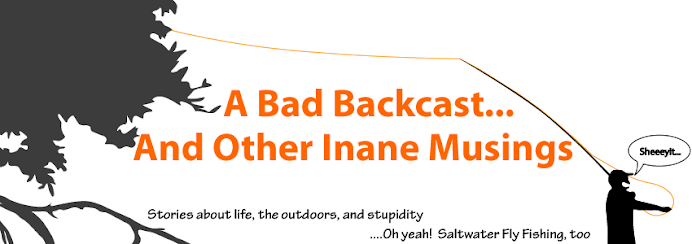I'm sure that none of you need to read this, but I'll post it anyway.
Is there really a difference?
So you've always wanted to fly fish in saltwater? Not just going after little weenie brook trout like they do up north, but honest to goodness big game saltwater fly fishing. You've mastered all of tactics needed to be a successful saltwater fisherman with spinning gear and you need a new challenge? This is a basic guide that will have you chucking fluff in no time.I distinctly remember wanting to get into the sport of saltwater fly fishing and not really knowing where to start. I combed the web looking at gear, watching videos and was amazed at how different fly fishing is compared to plying the brine with a spinning rod and reel. The first thing that I noticed was that there seemed to be a new language associated with anything fly fishing related. That's where we'll start this basic guide.
The Jargon
Here is some basic terminology that you'll need to understand before you start :
Weight -
Fly rods, fly reels and fly line is categorized by "weight". They go from 1 weight up to around 15 weight or so. The lower the number, the lighter the action and smaller fish you'll need to target.A good starting set up to use for saltwater applications targeting bonefish, redfish and snook would be nothing lighter than an 8 weight. This is subject for debate of course. I know folks who like to use 6 and 7 weight rigs in saltwater but you're going to need to be quite proficient in being able to land a large fish with a lighter rod, smaller reel and shorter line. For big game fish like tarpon or cobia, you probably want to use a 11 weight or higher to be able to deal with these bruisers. Of course, a larger weight means heavier rod, and larger reel adding to the weight of what you'll be holding. If you're not used to using a rig like this, you can wear yourself out in a hurry. A recommended place to start would be a 9 foot, 4 piece rod.
Backing -
Backing is line either gel spun or braided line that attaches from the reel to the fly line. The length varies by how much line the reel can hold. Most saltwater set ups should have 100 yards of backing and 200 yards for large, fast running fish.Backing can serve two purposes. One is to create a larger diameter spooling surface that allows the fly line to fill the entire fly reel. The other is to provide additional line for fighting heavy or hard fighting fish. A fast running or hard fighting fish may take line from the reel and get "into the backing". You can cheat and add backing capacity by using braided line such as power pro in a 20 lb test range. This tactic can add a longer length of backing without using a larger reel.
Fly Line-
This is what the angler uses to cast the fly. Usually made of plastic or composite, this gives the angler the ability to "load the rod" and present the fly to the fish. A good product for a beginning fly caster would be a "weight forward" line which is slightly heavier and thicker the first 30-40 yards of line out of the rod tip. This makes it easier to load the rod and can assist the newbie with tighter loops and higher line speed. There are floating lines, sink tip lines and sinking lines. A typical abbreviation in the fly fishing industry will look like this - WF8F which stands for "Weight Forward -8Weight - Floating."
Leader-
A leader is a length of monofilament line or fluorocarbon material that attaches the fly line to the fly so that the gamefish cannot see the fly line. Leader lengths are typically 9-10 ft long for salt water but longer leaders can be used in clear water conditions. A standard saltwater leader would be constructed like this - 4 foot butt section (the piece attached to the fly line) of 30 lb test - 3 foot section of 20 lb test - 3 foot section of 15 lb test.
Tippet-
This is a short section from the leader to to the fly usually made of heavy monofilament, fluorocarbon or wire material. For large gamefish with sharp gill plates, a standard tippet would be 10 inches long and be made of 30 - 40 lb test. For fish such as barracuda, a strong wire tippet made of 80-100 lb test is desired.
+Bigmouth.png)
No comments:
Post a Comment